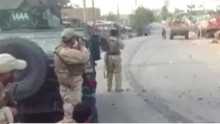Taliban take another area in Afghanistan, parliament member says
The Taliban have taken over the Warduj district of Badakhshan, east of Kunduz province, according to Fawzia Koofi, one of the first women to be elected to the Afghan parliament after the U.S. invasion of the country.
The Taliban takeover in Warduj province represents a new setback for the Afghan government, after the group reclaimed parts of the city of Kunduz earlier this week. That was the biggest victory the Taliban has had in 15 years. Kunduz is a strategic hub on the main highway between Kabul and Tajikistan.
Earlier Thursday, Doctors Without Borders staff working in a hospital in Kunduz were caught in the crossfire as the Taliban and Afghan security forces -- with help from U.S. troops -- battled for control of the provincial capital.
The medical staff bravely worked to treat the wounded as shells exploded and the ominous sound of rockets filled the air. Bullets broke windows and pierced the roof of the intensive care unit, Dr. Masood Nasim said.
"Our hospital was on the front line, with fighting outside the gate," he said. "But despite being in the middle of the fighting, our hospital and staff have been respected and we've been able to carry on our work."
Nasim, the medical team leader, said that since Monday -- when the Taliban said they had seized control of Kunduz -- the hospital had received at least 296 patients, including 64 children. Nearly 75 of them arrived in critical condition, and many were shot, he said.
The facility has a 92-bed capacity but the medical staff scrambled. They put patients in offices and examination rooms and stabilized many on mattresses on the ground.
"Our surgeons have been treating very severe abdominal wounds and limb and head injuries," he said. "The hospital has been completely full of patients."
While they fought to save lives, competing narratives circulated over who was winning Kunduz.
Early Thursday, the Afghan government said it had reclaimed most of the city in a big operation backed by U.S. airstrikes.
But hours later there were signs that the Taliban were back in Kunduz, a resident told CNN. Gunshots were heard near the airport, according to a resident who did not want to be named for security reasons.
The U.S. role
U.S. Special Forces advisers in the country said in a statement that Afghan Security Forces had Thursday "encountered an insurgent threat in Kunduz" to which U.S. Special Forces returned fire to "eliminate the threat."
The statement stressed that Afghan Security Forces have full responsibility for their operations in Kunduz, but U.S. service members have the right to protect themselves.
At least 150 Taliban fighters were killed in Kunduz with 50 others dying in Baghlan and Takhar, Afghan Interior Ministry spokesman Sediq Sediqqi tweeted. The Khawja Ghar district was also retaken by Afghan forces, according to Sediqqi.
Taliban spokesman Zabiullah Mujahid insisted the militants weren't done fighting in the city yet and had regained ground since the government's advance.
The Taliban remain in control of at least two districts in the rest of Kunduz province.
The Taliban's takeover of Kunduz was the first time they had driven government forces out of a provincial capital since the Islamic extremist group was ousted from power in 2001.
The defeat intensified doubts about Afghan troops' ability to take on the militants now that the U.S.-led coalition has stepped back from front-line combat. It also showed the Islamic extremist group's resilience despite recent internal divisions under its new leader.
Why is the Taliban takeover of Kunduz a big deal?
The Taliban's rise and fall


The Taliban attack Monday, in which government officials say the militants cunningly "infiltrated" the city, was preceded by a monthslong buildup of insurgent forces in the surrounding region. And yet the Afghan security forces, who outnumbered their enemy, appeared unprepared or unwilling to defend it.
After losing Kunduz on Monday, Afghan troops initially struggled to retake it. Many of them remained dug in at the airport on the outskirts of the city while the Taliban prevented reinforcements from getting through from neighboring Baghlan province.
The situation on the ground in and around Kunduz has often appeared confused, with the Taliban and the government both claiming to have gained ground and inflicted heavy casualties on the other side.
The Afghan Defense Ministry said the operation to retake the city had killed 150 Taliban fighters. But it didn't provide any information about casualties on the government side.
Hundreds of civilians wounded
Many civilians were caught up in the fighting and thousands fled Kunduz, according to the United Nations. They left by truck, rickshaw or horse -- and some on foot.
Taliban takes over Afghan city


Nicholas Haysom, the U.N. special representative for Afghanistan, said that under Taliban control of the city there were reports of "extrajudicial executions, including of health care workers, abductions, denial of medical care and restrictions on movement."
One male resident of Kunduz told CNN on Wednesday that shops were closed, there was a citywide power blackout and it was becoming difficult to find food.
"Kunduz has turned into a ghost city," the man said, reporting that he had been hurt by shrapnel after getting caught in a firefight. He spoke on condition of anonymity, fearing retribution.
Pictures and video posted to social media from Kunduz after the government said it had retaken control showed citizens out on the streets.
News Courtesy: www.cnn.com











